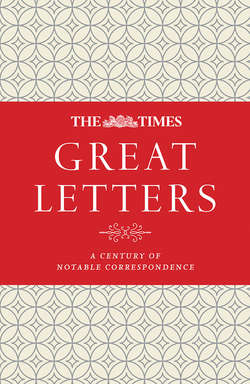Читать книгу The Times Great Letters: A century of notable correspondence - James Owen - Страница 5
ОглавлениеINTRODUCTION
Before 1914, there was no Letters Page as such in The Times. The newspaper had, since its founding in 1785, published correspondence to it. Yet in the era when its front page was still reserved for items of more importance than mere news — club announcements, death notices and public appointments — letters had to be fitted in as space allowed rather than gathered together: let alone considered an attraction in their own right.
Although the change did not become fixed for some years, the decision to start grouping letters onto a single page when possible began to alter their nature and function. Until well into the previous century, those published had often been immensely lengthy (and now almost incomprehensible) political polemics.
That Victorian taste for abundance had begun to dwindle by the time of the First World War and the advent of the motor car and the telephone had led to predictions of an imminent end to letter-writing. But while the constraints of the new lay-out often did encourage correspondents to be briefer, its introduction turned the page into the noticeboard of the Establishment.
Rapidly, it took on the character for which it has become renowned, as a forum for debate, as a playground for opinion-formers and as a billboard for decision-makers. From the start, however, such weighty content was leavened by humour and quirkiness. Moreover, with readers making a regular appointment with the page, another of its features became more pronounced: rallies of letters, with each mail bringing a fresh serving of wit and erudition.
Indeed, what is most striking about this selection of letters, across the years, is the sense of community between readers that emanates from them. Of course, what that community was has changed markedly over time. For much of the first half of this volume, it was largely that which treated the page as an extension of their gentlemen’s club. The tone and content accordingly reflects their self-assurance and their preoccupations — cricket features strongly, as do mentions of Eton; and sometimes both together.
Not until well into the post-war years does the mood become more sombre, pondering (if not resolving) the uncertainties of imperial twilight and economic decline. By then, the readership is notably broader, as changes in education, society and at work bear fruit: in the 1970s, more Labour than Conservative MPs took The Times. Nonetheless, it is remarkable how frequently the same topics recur in correspondence across the generations — the failings of the young, what is to be done about schools, how best to make porridge.
For it seems to me that the value of these letters lies not just in the great events which often they record, be it the death of Elvis Presley or the onset of the internet, nor even in the changing attitudes that they mirror, but in the window that they offer on the national character. Unconsciously revelatory they may be, but the fascination of so many of these letters is their insight into what it means at any time to be British. They take the temperature of the body politic, map the A–Z of our way of life.
They are a reminder, too, that the writing of letters (and emails), and not just of books, can be an art form. Here are Margaret Thatcher, Benito Mussolini and Theresa May giving glimpses of what took them to the top. Meanwhile, Spike Milligan, PG Wodehouse and Celia Johnson use comedy to have their say.
There are masters of the craft to be rediscovered here, among them AP Herbert and Peter Fleming. Graham Greene, John Le Carré and Agatha Christie demonstrate why they made their living from their pens, even if a taxi driver puts TS Eliot square about the limits of Bertrand Russell’s intellect. And Arthur Koestler makes the case for a tax on pleasure (with married love to be zero-rated).
If a Hungarian-born intellectual can be moved to write amusingly in his sixth or seventh language to a newspaper, it must be doing something right. At its best, that is to draw its readers into a long, ongoing conversation about the direction of the nation, what shape it is in and which qualities it should exude.
What is important is that dialogue is open to anyone who reads the paper, not just those who are influenced by its readers’ views, or who seek to influence them. Not everyone understands the rules at once, as the first letter hereafter shows (“How to Have a Letter Published”).
But it is hard to think of another group of readers who, wanting to protest a decision by local councillors about an exhibition, would spontaneously adopt the personae of literary characters relevant to their cause (“The Curious Case of Sherlock Holmes”, which can be found at the start of the book). That ability to make your point whilst retaining your sense of humour is perhaps uniquely — and the best of — British. If newspapers can have a soul, it can be found here, on the Letters Page.
Where it might be helpful, I have added brief contexts to some of the letters which follow. Similarly, the capacities in which correspondents write and their addresses have also been included as seems necessary. Notwithstanding the passage of time, the style and usage of language in the letters, and the views expressed in them, remain those of the original.
JAMES OWEN
